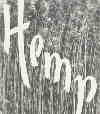
|
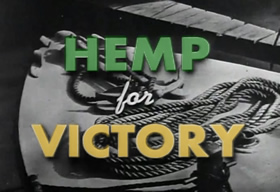 DURING THE SECOND WORLD WAR |

|
|---|
4.0 - OUR INDUSTRIAL HEMP INDUSTRY
- ON THE EVE OF THE WAR:
So far everything that we have covered in previous sections has been nothing more than a build-up to this point, which is essentially the situation that we found ourselves in as a nation just before Pearl Harbor and our entry into the War. A situation that (as sad as it is) would have been out and out comical had it not so seriously damaged our country’s military abilities at such a critical time. There are some who even go so far as to suggest that Harry Anslinger (our drug czar at the time) was little better than an Axis saboteur.
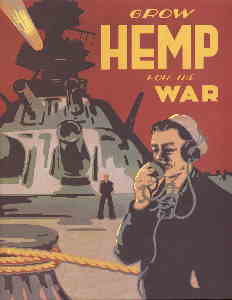
|
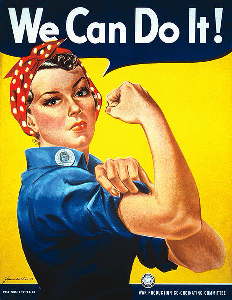 |
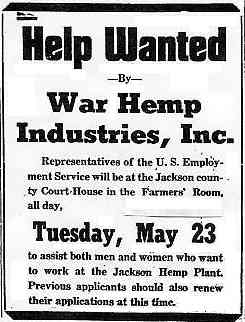
|
|---|
THROUGHOUT THIS SECTION, WE WILL SEEK TO ADDRESS THE FOLLOWING QUESTIONS:
- What was the Big Deal and why should anyone care about cordage materials?
- What specifically was so special about Industrial Hemp?
- Why not some other fiber plants?
- As we were importing our cordage needs before the war, why not simply continue to import?
- Why domestic growth? Why not grow in Latin America and simply import?
As we have seen in previous sections:
- At one time our Home Grown Hemp Industry was considered so vital, that it was even against the law for American farmers NOT to grow it.
- Throughout the 19th Century and well into the middle of the next one, Hemp products were so commonplace that they were to be found in just about every home in America. Hemp (as we have seen) had a wide variety of consumer uses; everything from children's Jump Ropes to clothes, furniture, rugs, etc., not to mention industrial and military uses.
- However, starting in the late 1800’s (mostly for economic reasons), American farmers began to abandon Hemp growth for other more lucrative crops. Simply put, they couldn’t compete with the cheap foreign imports. This was especially true after America’s annexation of the Philippines and their massive Manila Hemp plantations. [ Note - America outlawed slavery in 1865, but the Philippine plantations didn’t seem to notice. We simply couldn’t compete. ]
- However while America’s Home Grown Hemp farming was in decline, America’s Industrial uses of cordage materials (such as hemp) was not. It was still steaming along, but now making use of foreign (and/or Filipino) imports.
- While true, especially into the mid-20th Century, innovations like plastics were making inroads into products formally manufactured solely from Hemp. Still, it appears (at least from old advertisements) that Hemp was still holding its own and holding its own strongly
Thus on the eve of war, our country found itself in a situation where (due to a chain of historical events) we were dependent on imports for most of our cordage needs. And as has been shown in previous sections those needs both civilian and military were great indeed.
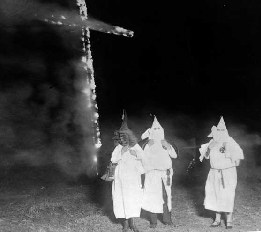
|
There are still many who falsely believe that it was Richard Millhouse Nixon who first created the anti-Marihuana laws. . . . Also see section V dealing with conspiracies. |
4.1 - OUR INDUSTRIAL HEMP INDUSTRY
- THE EARLY DAYS OF THE WAR:
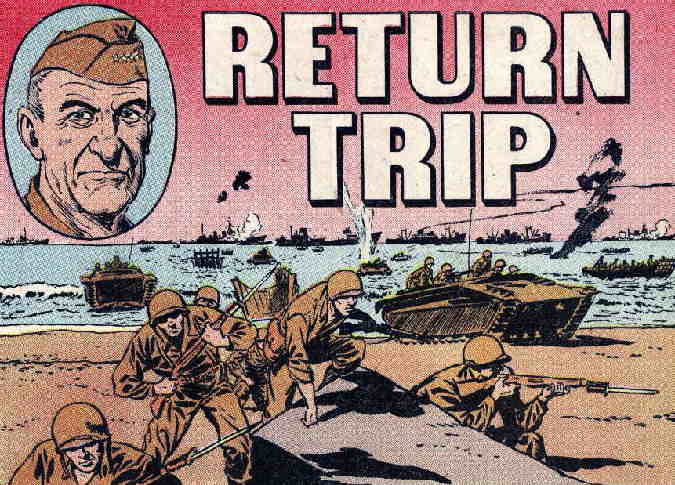
Perhaps the best way of addressing our original questions is to place yourself in the shoes of some hypothetical cordage purchasing clerk. One who was lucky enough to have held on to their job throughout the Great Depression at a cordage factory, which at one time or another had manufactured tents, belts, duffel bags, ropes and twine. And at one point during the Depression had even tried its hand at manufacturing a line of work pants.
Previous to the war (as a purchasing clerk), your main problem had simply been to locate the cheapest source of raw materials (cordage) possible. If it was too expensive, you simply said NO, and for good reason. Before the war (again during the great depression), buyers were few and supply was plentiful.
Your favorite sources of supply came from Italy, or the Balkans. The quality of their Hemp was good and the prices very reasonable. While on the other side of the globe, cordage imports from the Philippines where always available - as was Hemp from Indonesia, jute from India, etc. There were even Chinese vendors offering you Hemp from China, and Mexican vendors where constantly on the call, offering you raw Mexican sisal cordage.
So, previously your job was simply to obtain the cheapest possible cordage available, and supply had never been a problem. Now, just weeks after Pearl Harbor, what before had been a trickle of order had now turned into a torrent. Specifically, the military was now asking you to manufacture a whole host of things for them:
| ● Parachute Harnesses | ● Canvas tops for their vehicles |
|---|---|
| ● Army belts and pouches | ● Military back packs |
| ● Duffel bags | ● Army Tents |
| ● Torpedo Nets Plugs (used to plug holes below the water line) | ● Portable sleeping bunks and hammocks |
| ● Naval Grommets (some of these are waterproof) | ● Aircraft, navel Webbing |
| ● Caulking material | ● Fire hoses |
And there is more...a lot more. So much in fact that this list of requests seemed endless to you. But there was a major problem. While your firm wanted to produce as much as it could, you quickly started to run into a major problem of a lack of raw materials. Within four days after Pearl Harbor, Italy (an AXIS power at the time) declared war on America, thus effectively cutting off Italian Hemp exports to our country. Next came the reality that the AXIS were also in control of most of the Balkans. Assuming supply ships could run the gantlet of AXIS submarines, few imports could be expected from that geography.
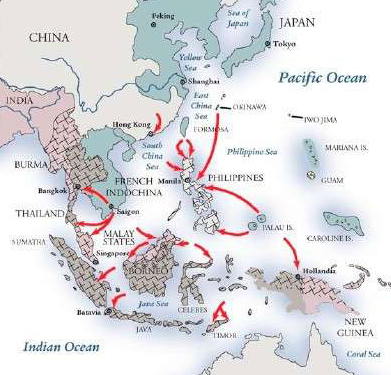
Next, comes the news that the Axis has just seized control of not only the Philippines but Indonesia as well. Both were important sources of raw cordage material. And to add to your worries, next comes the news that the AXIS has seized the island nation of Singapore; meaning that their navy was now in a position to STOP all Jute imports from India. (see map) So you (as a purchasing clerk) next try to buy cordage materials from our friends in Latin America only to find out that they never grew that much anyway, and worse yet, due to U-Boat activity in the Caribbean, supplies were hard to come by anyway. Even Mexico, which grows sisal (a cordage material) in the Yucatan, simply couldn’t help that much.
So (almost in desperation) you finally try to buy cordage materials from domestic producers. But you quickly find out that, courtesy of years and years of cheap imports, not to mention the crescendo of the reefer madness campaign, that there aren’t that many Hemp farmers left.
Now what do you do? How do you produce those war goods that you counrty now so desperatly needed?
This was the situation that we found ourselves within the first few days after our entry into the war. A situation that quickly became apparent to just about everyone and specifically to those in Washington running the war effort.
The solution, the only thing that could have been done actually, was obvious. Somehow, America had to re-establish its old but now almost extinct Home Grown Hemp Industry. BUT WAIT;-- What about the Reefer Madness Hysteria Campaign? What about a whole slew of anti-hemp State Laws?
[NOTE: Section IV, deals specifically with conspiracy theories. How we could have gone from Reefer Madness one day to Hemp for Victory the next, and then back to Reefer Madness after the war. – But for now . . . ]
To para-quote President Franklin D. Roosevelt;
“Mr. New Deal has given way to Mr. Win the War.”And with that, the “Hemp For Victor” campaign was on.
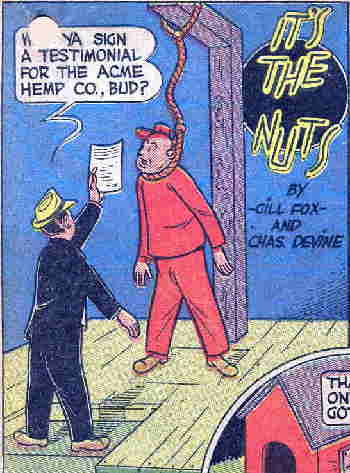
|
“Will you sign a testimonial for the Acme Hemp Co., Bud?” |
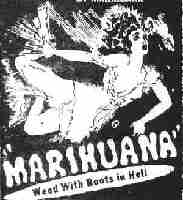
|
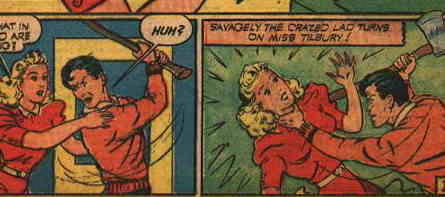 |
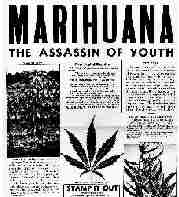
|
|---|
4.2 - OUR WW2 HEMP INDUSTRY
- - REEFER MADNESS THE PSYCHOLOGICAL DAMAGE:
As that (hypothetical) purchasing clerk (sec. 4.1) could tell you, there was nothing really special about cordage made from Hemp. In most cases (not all, but in most) just about any other cordage material would have worked. Our problem was that we couldn’t get our hands on any. And with imports out of the question, Home Grown Cordage materials would have to suffice. And while other crops must have been looked at, it appears that due to climate/soil conditions, the only stuff that we could realistically grow in North America was Hemp.
HOWEVER, THERE WAS a bit of a major and now very embarrassing, problem now associated with Hemp growth. One which like the 800-pound gorilla in the room, simply couldn’t be ignored. What we now know of today as the Reefer Madness hysteria campaign.
Recalling that since the 1920’s, first local, then state, then federal police officials were going around claiming that Marihuana (a new racist term they coined for the Hemp plant) or the Mexican Opium plant, was causing its users to go around committing crimes of violence. That the most bestial crimes were directly linked to its use.
A campaign (discussed elsewhere) that had by this point (early 1942) caused many in America to actually believe it was true. SO HERE IS THE PROBLEM: how do you persuade a farmer out in the middle of the mid-west to grow something that, according to your own government, makes individuals go around killing, raping, looting, whatever, other people? For the reader not familiar with the subject, we’ve found that the following encyclopedic definition best explains the campaign in a nutshell:
WEBSTER’S ENCYCLOPEDIC DICTIONARY OF THE ENGLISH LANGUAGEThis presents us with a situation that of-and-by-itself raises some important moral issues. Assuming you actually believed what our narcotics police were telling us was true.
-- STUTTMAN Co. (1957) -- (pg. 2681)
MARIJUANA . . A weed or herb, growing in many parts of North America; the dried leaves of the plant, which have narcotic qualities when smoked in cigarettes; sometimes called the assassin of youth. . . . Marijuana, or Hashish, a subtle, crazing drug which is being surreptitiously sold in U.S. in the form of cigarettes. Narcotic officials named it 'The Assassin of Youth,' and state that it is as dangerous as a coiled rattlesnake. Its effects when smoked vary with different Individuals. It may make of its victim a philosopher, a joyous reveler, a mad insensate, or a fiendish murderer. Its purveyors whisper into the ears of Am. youth the wonders of a new cigarette with a real thrill, and without harmful effects. Students are lured to its use by promises of resultant keenness of mind, the easy solving of problems, an aid in exams. An addict was hanged in Baltimore in 1937 for a criminal assault on a ten-year-old girl. In Fla. a crazed youth killed his father, mother, two brothers, and a sister. In more than 30 cases of murder or degenerate sex crimes in 1937, marijuana proved to be a contributing cause. See Hashish.
Then how could a government official, any government official, work with, or for that matter, any farmer deliberately grow such a deathly drug? And granted, America was at war, but if Marihuana really was “The Killer Drug” as it had been called. Then how could anyone other than a ghoul have anything to do with it? In fact, wouldn’t it have been counter to the war effort to have who knows how many thousands of individuals running around killing and/or jumping out of windows under it’s deadly influence?
And here it is important to note that there were indeed well meaning individuals and groups who did oppose America’s Hemp For Victory program during the war.

|
|
|---|
However, despite such protests, opponents of the Hemp For Victory program were rather few in numbers, And unlike in the past, the very organs of the propaganda campaign that had created the Reefer Madness hysteria campaign in the first place had now been totally turned around against them. Where before it was “Marihuana -- the Assassin of Youth,” now (like a light-bulb switch had been turned off), now it was touting the patriotic duties farmers had toward their nation. Simply put, the very propaganda machine that had created the Marihuana laws in the first place had now reversed course.
Maybe the best example of this is a WW-2, full-page advertisement, imploring farms to grow what was once the unthinkable.
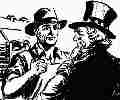
|
Mr. Farmer, grow Hemp for the War Effort |
|---|
[more about this subject in Sec. 4.5 ]
4.3 - HEMP FOR VICTORY
- AMERICA’S HEMP CZAR:
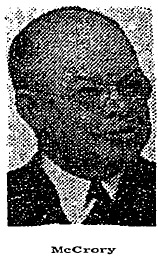
AMERICA’S HEMP CZAR:
No doubt there are those in today’s world who would like us to forget the whole thing. But YES America, we really did have a Hemp Czar throughout the war (although he didn’t like the term). And by all accounts, Mr. S.H. McCroy did a pretty good job. As the Washington Post (12-07-1946p7) put it:
“During the war he headed the nation-wide hemp program of the Commodity Credit Corp., which produced and processed over 200 million pounds of hemp for the military and essential civilian use, replacing previously imported fibers”Which by anyone’s standards was quite a good job. . . . MORE . . .
4.4 - HEMP FOR VICTORY
- THE FARMERS:
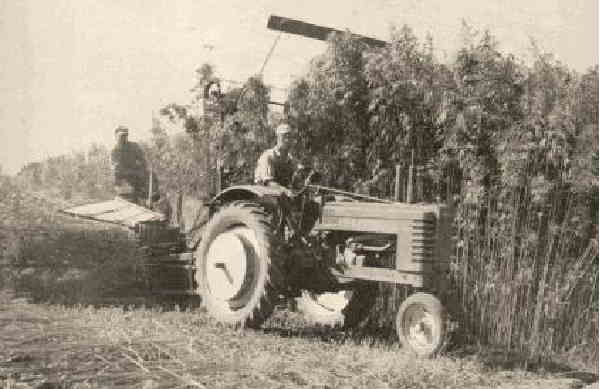
THE FARMERS:
Those who actually grew the Hemp crops during the war. To some they were and remain little better than a bunch of ghouls, growing a crop of despair and woe. But to most, they were true patriots who answered their country’s call in its hour of need . . . .MORE . . .
4.5 - HEMP FOR VICTORY
THE OPERATIONAL HEMP MILLS:

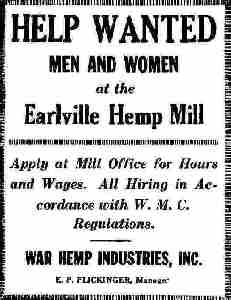
THE HEMP MILLS
As peviously brought out, due primarily to cheap imports (not to mention the hysteria campaign), our Home Grown Hemp Industry had fallen on such hard times that 72 new government owned processing mills had to be built from scratch. These mills (along with a few privately own mills) were needed to process the now newly resurrected domestic Hemp crops . . .. MORE . . .

|
Where were these WW-II Hemp mills? . . . [more]. . . |
|---|

|
Various Help Wanted (Newspaper) Want Ads of interest. . . [more]. . . |
|---|
4.6 - HEMP FOR VICTORY
THE MILL WORKERS:
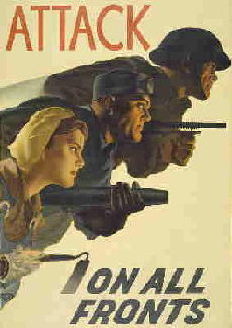
WHO WERE THE HEMP MILL WORKERS:
Excluding the management, the average Mill worker came from the local communities where the Hemp mills were built. As these hemp mills were almost exclusively located in small towns, meant that for the most part, these workers came from small town America . . . .. MORE . . .
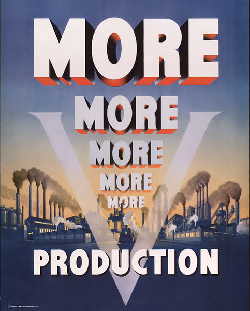
|
WAR WORKERS There are those who view these workers as nothing more then a group of Marihuana workers unwashed hippies. . . [more]. . . |
|---|

|
LABOR TROUBLES Many would like to believe the Hemp Industry was just perfect and everyone was in love with everything . . etc.. . . [more]. . . |
|---|
4.7 - HEMP FOR VICTORY
- EVEN THE BOY SCOUTS WERE EXPECTED TO CHIP IN:
(Even Children were expected to do their part for the War Effort)

While this comic book ad (True Comics #40) does not deal with hemp per say, note that it was
sponsored by the “War Hemp Industries, Inc.”
What just a few short months earlier was being referred to by our government as the “Assassin Of Youth.” Was now (in the words of Jack Harer), now so safe that even the “Boy Scouts were being asked to help grow it. And, Yes, Yes, it was the “4-H’s” and NOT the “Boy Scouts” that actually helped grow Hemp Seed during the war. However, due to the generic use of the term, the Boy-Scout’s was used to mean ALL youth groups and we’ll probably be making reference to them for a long, long time. . . . more . . .

|
All were expected to do their part in the war effort . . . [more] |
|---|
WANT TO KNOW MORE:
=====================
Due to space / download time considerations, only selected materials are displayed. If you would like to obtain more information, feel free to contact the museum. All our material is available (at cost) on CD-Rom format.
CONTACT PAGE
 BACK TO Sec. III HISTORICAL USES |
 |
 ON TO Sec. V POST WAR ERA |
 BACK TO MAIN HEMP FOR VICTORY PAGE |